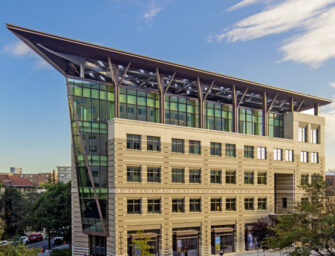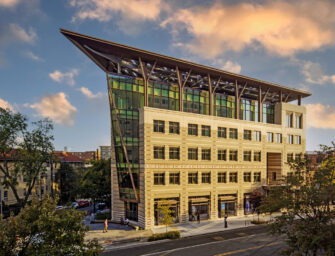Top recorded content picks from #AGU21
It was great to see the Earth and space sciences community at #AGU21, both in New Orleans and online everywhere.
But the AGU Fall Meeting is not over. For the more than 24,000 registrants who attended #AGU21, all of the content—sessions, posters and recorded talks—is available for viewing until the end of February.
Indeed, one advantage of a hybrid meeting is you can catch up on presentations that you missed, or re-watch and have access to particularly interesting sessions that you’d like to see again.
A great place to start is with the plenary presentations and the named lectures. These provide some great overviews of active research and the broad societal impacts across the Earth and space sciences. Find these in the online application by searching by the session name or number.
We have also compiled a list of top sessions based on live virtual attendance and views of recorded content and asked the AGU Board, Council, Editors-in-Chiefs of AGU journals and staff for some recommendations of particularly notable sessions and talks. Please find all these top picks below.
Do you have a session from #AGU21 that inspired you? Provide a recommendation here and we will share it in the coming weeks.
Note that access to all of these sessions requires that you were registered for the Fall Meeting. To enable the links, log in first here: https://www.agu.org/Fall-Meeting
Recommendations from AGU leadership:
- TH33G: Reciprocity in AGU: The Beginnings of an Indigenous Action Committee
- This townhall was conducted by members of AGU’s new Indigenous Action Committee (IAC). The IAC is addressing how reciprocity can be incorporated into AGU’s work and how they can catalyze this change within AGU.
- Plenary – Sekou Andrews – The Science of Wavemaking
- I was just so moved by Sekou’s presentation. Maybe I’m a sucker for perspectives which are different than mine but here I am, the meeting has been over for 3 weeks now and I’m still talking about this plenary with my colleagues. Splash. Splash.
- ED33A-01: the Dottie Stout Lecture presented by Emily Cooperdock
- Data-based presentation on DEI issues. Not just personal experiences, not anecdotes, but hard data, presented clearly and with deep feeling.
- EP51B-01: Detecting the Imprint of Climate Change in High Mountain Hazards: Challenges and Opportunities (invited)
- High mountain areas are showing some of the most obvious, detectable physical landscape signatures of modern climate change, with hazardous results. This talk was excellent and has high relevance to human societies as they prepare and manage effects of climate change.
- EP51B-02: Climate change and landscape instability in High Mountain Asia
- Excellent talk on some of the effects of modern climate change on physical landscape processes. Cutting-edge research in this area.
- U41B: The Anthropocene Comes Home: Innovation and Adaptation in Louisiana
- Incredible commentary and perspectives from on-the-ground researchers, community leaders, organizers and Indigenous experts in Louisiana.
- TH23H: Data FAIR Working Session: FAIR Workflows – Best practices, services, and tools for helping researchers increase the portability and reproducibility of their work.
- Great overview and discussion of the importance and challenges of sharing FAIR workflows.
- S25E-0295: An adaptive spectral subtraction algorithm to remove persistent cultural noise
- An intuitive and effective method to extract seismic event signals from data with high urban noise levels.
- The Anthropocene Comes Home (U41B)
- Excellent panel of community leads and other local to Louisiana folks about the various climate-related issues facing the state and what local groups are doing about it.
- Presidential Forum Lecture: Dr. Robert D Bullard – The Quest for Environmental and Climate Justice
- The entire thing was incredible. So many excellent points, and an amazing speaker. A quote: “Take your science and apply it for justice. … your science should be action oriented”
- SY51A: Science and Society: Community and Citizen Science I Oral Thorough and insightful discussion of community (and citizen) science.
- The panel discussion and SY51A-06 were especially good.
- Publications sessions for authors (multiple events)
- Here is the full set of presentations, among which are several that would be very useful for AGU authors (especially early-career ones) to learn from. Some of the standouts might be: how to submit your first paper, what makes a paper reviewable, how to make good figures, and how to spread your work more widely with plain-language summaries. https://www.agu.org/Publish-with-AGU/Publish/pubs-fall-meeting-events
- AE12A-02 – How will lightning change during the pollution-reduced COVID-19 pandemic period? A data study on the global lightning activity
- Here’s a quick layman’s summary: There have been various studies on the impact that aerosols from manmade pollution impact have on the frequency of lightning occurrence. The onset of covid-19 and the shutdowns which radically reduced vehicle emissions was a natural experiment to test it out. The study found a statistically significant 10-20% reduction, globally, in the amount of lightning that occurred in the three months of covid lockdowns.
- OS31A. Rachel Carson lecture
- Excellent lecture by Andrea Grottoli on the future of coral reefs. The talk combines new science with recommendations for community approaches to research on a global problem and for management.
- GC42D-01 Climate Change and Water Resources—A History of Scientific Methods and Findings
- Masterful recap of the history of how hydrologists have theorized about climate change in the face of data that keeps blowing apart their theories – with loads of specific implications for policy and practice.
- PP31C–Human Responses to Late Quaternary Paleoenvironmental Change
- There were a bunch of presentations in this session about fascinating work investigating how past episodes of climate change likely affected human migrations and other behaviors.
- U31A – Translating Critical Remote Sensing for the Geosciences: Politics, Ethics, Economics, Empowerment, and Other Important Issues
- Very dynamic discussion among early career leaders asking hard and important questions about “Critical Remote Sensing” – an emerging field of study that takes a step back to evaluate remote sensing itself. Important discussion of social justice issues.
- PP32A Emiliani Lecture ‘Community Efforts to Document and Refine Paleoreconstructions
- The talk was a perfect discussion of what the paleoclimate community has completed in terms of carbon dioxide reconstructions and where we need to go next.
- U51B: Open Science in Action
- Great overview of many of the popular technical tools used in Earth and space science research. I particularly recommend the 30-minute tutorials.
- U52A: Assessment and Accountability of Scientific Knowledge Creation: Considering the Contributions of Geosciences Toward the Global Social Challenges
- Broad discussion (and survey results) of research culture and a thoughtful and somewhat provocative plenary talk by Michael Wysession starting at 37.00 mins.
Top 10 Sessions based on live virtual attendance:
- The Grand Transformation needed to address Climate Change – Part 2
- Presidential Forum Lecture: Dr. Robert D Bullard – The Quest for Environmental and Climate Justice
- The Grand Transformation needed to address Climate Change – Part 1
- COP26 – Summary and Discussion
- Plenary – Sekou Andrews – The Science of Wavemaking
- Intergovernmental Panel on Climate Change (IPCC) Working Group I 6th Assessment Report
- LANDInG Launch Lecture: Dr. Kelly Mack
- Fire and Smoke: Biomass Burning Emissions, Chemical Evolution, and Impacts on Air Quality and Climate
- Advances in Remote Sensing for Monitoring Biodiversity Change: Integrating Data and Models Across Scale
- Carl Sagan Lecture
Top 25 most-viewed recorded content:
- SH13A-01 Coronal Heating: A Coupled Multi-Scale Problem
- A11B-01 Assessing the contributions of anthropogenic aerosols to weather and climate extremes
- Presidential Forum Lecture: Dr. Robert D Bullard – The Quest for Environmental and Climate Justice
- A21A-01 Convective Deep Inflow: Consequences and Cause
- A41D-01 Evaluation of CMIP6 and quantifying progress of climate models across different CMIP phases with the ESMValTool
- GC21B-01 Droughts and climate change: The role of drought-vegetation-climate interactions
- A21G-01 What can we Learn about Cirrus Clouds and Ice Nucleation from the Decrease in Anthropogenic Emissions During the Pandemic?
- A31F-01 Understanding climate change through Earth’s energy flows
- PP11B-01 Globally resolved climate changes since the Last Glacial Maximum: new insights from models and proxies
- T11D-02 Spatio-Temporal Variations in Localization of Shallow Creep on the Southern San Andreas Fault
- P21B-01 Ten months of Perseverance on Mars
- EP13B-01 Sensitivity of Topography and Erosion Rate to Climate and Tectonic Forcing
- G22A-04 How does Tibet deform? A high-resolution 3D velocity field for the India-Eurasia collision from Sentinel-1 InSAR and GNSS.
- G21A-01 Tectonic Geodesy of Western Myanmar: Strain Partitioning and Active Subduction Revealed by a Dense New GNSS Velocity Field
- H12E-01 Deep learning prediction of transport in porous and fractured media
- H13E-07 Characterizing Nonlinear, Nonstationary, and Heterogeneous Hydrological Response Using Ensemble Rainfall-Runoff Analysis.
- S21A-03 InSAR Data Reveal Induced Slow-Slip Fault Activation in Northern Canada
- G22A-07 Say Bye to Blobbiness: Getting the Sharpest Strain Rate Map out of InSAR Velocities — A Case Study of the NE Tibetan Plateau
- A24D-01 Future projections of the large scale atmospheric circulation: our biggest uncertainties and progress through the CMIPs
- A51D-01 Monitoring and Understanding of Global Tropospheric OH
- S31A-03 Earthquake Phase Association with Graph Neural Networks
- T11D-01 Measuring the Degree of Strain localization along Coseismic Surface Ruptures Using Optical Image Correlation: Implications for Understanding Fault Mechanics and Displacement Hazard
- S21A-04 Insights for evolution of induced earthquake clusters from a high-resolution catalog for Oklahoma
- S31A-02 FastMapSVM: Classifying seismograms using FastMap and Support-Vector Machines
- SH11A-01 Patches of the magnetic switchbacks: hints of their origins



There are no comments
Add yours